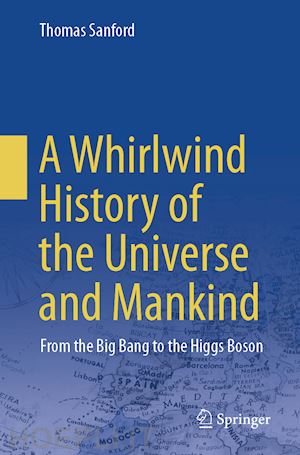

Questo prodotto usufruisce delle SPEDIZIONI GRATIS
selezionando l'opzione Corriere Veloce in fase di ordine.
Pagabile anche con Carta della cultura giovani e del merito, 18App Bonus Cultura e Carta del Docente
This book is an essential read for everyone who is curious about how we humans came to exist and interested in understanding the science and social evolution that enabled us to establish that a Big Bang actually happened. The text uniquely explains the transitions between the various evolutionary plateaus: from the universe’s beginning in the Big Bang, to the emergence of Homo sapiens, highlighting the Mediterranean civilizations of Greece and Rome, the European Renaissance, the English industrial revolution, and the early European science discoveries, particularly those in physics, to the American Manhattan Project and the subsequent development of the new field of high-energy particle physics. This entire route, which eventually culminated in the discovery of the mass-giving Higgs boson, is clearly articulated in this monumental but concise work.
PART I: Beginning.- 1. Introduction.- 2. Matter Universe.- 3. life.- PART II: Humans.- 4. Human Evolution.- 5. Agricultural Revolution.- 6. Mediterranean Development.- 7. Europe's Beginning.- 8. Transition: 1500-1700 (The Known World Expands).- 9. Modernity: 1700-1900.- PART III: Physics.- 10. Physics: 1700-1800.- 11. Physics: 1900.- 12. Physics: 1900-1950.- 13. Particle Physics: 1950-2023.- 14. Summary.
Thomas Sanford received his Ph.D. in physics from Columbia University under the guidance of Nobel Laureate Leon Lederman in 1972. Following his graduation, he conducted high-energy physics experiments at the Rutherford Appleton Laboratory in England, the CERN (European Council for Nuclear Research) Laboratory in Switzerland, and the Brookhaven National Laboratory in New York, participating in the discovery of the charm quark. In 1982, he joined Sandia National Laboratories in Albuquerque, New Mexico as a senior member of technical staff, and became a distinguished member in 1991, where he engineered a break-through in the physics of Z-pinches, opening wire arrays as possible drivers for inertial confinement fusion. In 2000, he became a fellow of the American Physical Society and in 2005 was awarded the Hannes Alfven Prize by the European Physical Society. He is retired from the Sandia National Laboratories, and currently lives in Albuquerque.











Il sito utilizza cookie ed altri strumenti di tracciamento che raccolgono informazioni dal dispositivo dell’utente. Oltre ai cookie tecnici ed analitici aggregati, strettamente necessari per il funzionamento di questo sito web, previo consenso dell’utente possono essere installati cookie di profilazione e marketing e cookie dei social media. Cliccando su “Accetto tutti i cookie” saranno attivate tutte le categorie di cookie. Per accettare solo deterninate categorie di cookie, cliccare invece su “Impostazioni cookie”. Chiudendo il banner o continuando a navigare saranno installati solo cookie tecnici. Per maggiori dettagli, consultare la Cookie Policy.